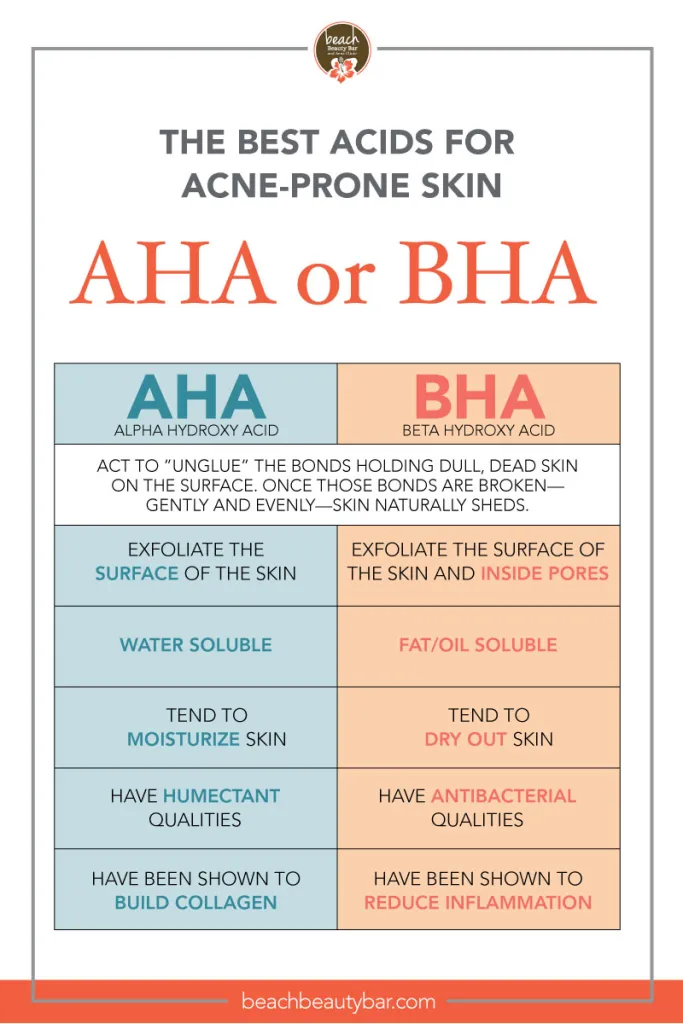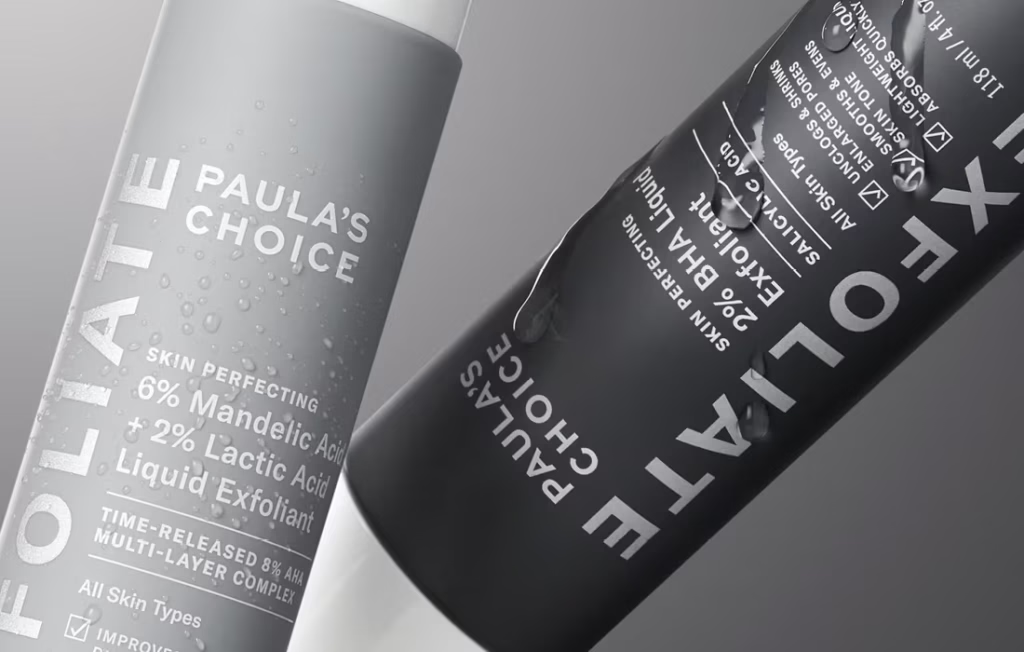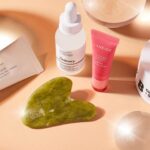Medically Reviewed by: Dr. Sally Bregner, MD, Board-Certified Dermatologist
Exfoliation is one of the most essential steps in any skincare routine. It helps slough off dead skin cells and unveils the brighter, smoother, and healthier skin beneath. But not all exfoliants are created equal. Enter AHA (alpha hydroxy acid) and BHA (beta hydroxy acid), two chemical exfoliants celebrated for their remarkable skincare benefits.
If you’re confused about which one to use (or whether you can use both), this guide breaks it all down, so you can make informed decisions for your unique skin type and concerns.
What Are AHAs?
AHAs, or alpha hydroxy acids, are water-soluble exfoliants primarily derived from natural sources, such as sugarcane or milk. Common AHAs include glycolic acid, lactic acid, and mandelic acid.
These acids mainly work on the surface of the skin, loosening the bonds between dead skin cells to promote faster cell turnover. The result? A brighter, more even complexion, reduced fine lines, and smoother texture.
Here’s a breakdown of different types of AHAs (Alpha Hydroxy Acids):
- Glycolic Acid: Sourced from sugarcane, it’s the most common and strongest AHA due to its small molecular size, which allows for deeper penetration—but it can also be the most irritating. Best for normal to oily skin types.
- Lactic Acid: Derived from milk, it’s a gentler option compared to glycolic acid and ideal for sensitive or dry skin. It exfoliates while boosting hydration.
- Mandelic Acid: Extracted from bitter almonds, this mild AHA works well for sensitive skin and is often combined with other acids for better results. It’s great for acne-prone skin.
- Malic Acid: Found in apples, it’s a weaker AHA that’s typically paired with stronger acids. It offers mild exfoliation and hydration.
- Tartaric Acid: Sourced from grapes, it’s primarily used to stabilize the pH levels of other acids, enhancing their effectiveness.
- Citric Acid: Derived from citrus fruits, it acts as both a pH regulator and a natural preservative. It provides mild exfoliation and brightening benefits.
Different AHAs target different skin concerns, so choosing the right one depends on your skin type and goals!
Best for:
- Normal to dry skin
- Uneven skin tone and texture
- Dullness
- Fine lines
Product Recommendation:
Try a Glycolic Acid Serum to boost radiance or a Lactic Acid Lotion for a gentler touch on sensitive skin.
What Are BHAs?
BHAs, or beta hydroxy acids, are oil-soluble, which means they can penetrate deep into pores, making them ideal for tackling oily skin and acne. The most common BHA is salicylic acid, known for its ability to unclog pores and reduce inflammation.
BHAs are great for clearing blackheads, preventing breakouts, and soothing irritation—all without drying out the skin.
Best for:
- Oily and acne-prone skin
- Blackheads and large pores
- Skin prone to redness
Product Recommendation:
A Salicylic Acid Cleanser is an effective yet gentle way to incorporate BHAs into your routine.
Are AHA and BHA Good for Skin?
Absolutely! Both AHAs and BHAs offer unique and complementary benefits for the skin.
- AHAs improve surface issues like dullness, fine lines, and uneven tone.
- BHAs target clogged pores, excess sebum, and breakouts deeper within the skin.
When used correctly, these acids can be powerful allies for achieving smoother, healthier-looking skin. Many users (including myself!) have seen noticeable improvements. For instance, using a BHA cleanser helped clear up my persistent blackheads, while an AHA lotion significantly improved my skin’s texture.
Why Are AHAs and BHAs Different?
The primary difference lies in how AHAs and BHAs work and what they target.
- Solubility: AHAs are water-soluble and focus on surface exfoliation, while BHAs are oil-soluble and work within the pores.
- Uses: AHAs are ideal for dry or uneven skin types, while BHAs shine in treating oiliness and acne.
- Sensitivity: AHAs tend to be more hydrating, while BHAs often have anti-inflammatory properties, making them suitable for sensitive, acne-prone skin types.
Can You Use AHA and BHA Together?
Yes, you can—but with caution. When combined thoughtfully, AHAs and BHAs can complement each other beautifully by addressing surface-level and deeper skin concerns simultaneously. Just make sure to introduce them gradually to avoid irritation.
For beginners, alternate between using an AHA and a BHA on different days or at different times of the day—such as applying an AHA at night and a BHA in the morning. Always finish with sunscreen during the day, as exfoliants can make your skin more photo-sensitive.
Pro Tip: Consulting a dermatologist, as I did, is always a good idea before incorporating new exfoliants into your routine. They can help you customize a regimen that works best for your skin.
How to Use AHAs and BHAs
- Patch Test
Always patch-test new products to see how your skin reacts, especially if you have sensitive skin.
- Introduce Gradually
Start by using your chosen AHA or BHA 1-2 times a week, then gradually increase frequency if your skin tolerates it well.
- Pair with Moisturizer
Follow up with a hydrating moisturizer to prevent dryness and irritation.
- Always Use SPF
Both AHAs and BHAs can make your skin more sensitive to the sun, so sunscreen is a must to protect it.
- Don’t Overdo It
Avoid combining multiple exfoliating products (including scrubs) in the same routine, as this can damage your skin barrier.

Can AHA and BHA Damage Skin?
When used correctly, AHAs and BHAs are safe and effective. However, overuse or using highly concentrated products without guidance can lead to irritation, redness, and a compromised skin barrier.
For example, while using a glycolic acid serum daily improved the smoothness of my skin, jumping straight into nightly use without building up tolerance might have caused peeling. Always pay attention to how your skin responds and adjust accordingly.
Glow On with Confidence
Understanding the difference between AHAs and BHAs is the first step to unlocking their potential in your skincare routine. Whether you’re clearing stubborn blackheads with salicylic acid or smoothing out uneven tones with glycolic or lactic acid, these exfoliants are tools for radiant, healthy skin.
Are you ready to give your skin the care it deserves? Explore our featured products, like the Salicylic Acid Cleanser, Glycolic Acid Serum, and Lactic Acid Lotion, to find your perfect match.

References
[edit]
- ^ “Exfoliation – Definition and More from the Free Merriam-Webster Dictionary”. Merriam-webster.com. Retrieved 2 December 2014.
- ^ “Exfoliation: Benefits, Risks & Types”. American Cosmetic Association. Archived from the original on 8 February 2023. Retrieved 8 February 2023.
- ^ Jump up to:a b Alex Muniz. “Exfoliation – AskMen”. AskMen. Retrieved 2 December 2014.
- ^ “Exfoliation”. 31 March 2008. Archived from the original on 18 September 2021. Retrieved 18 September 2021.
- ^ Jump up to:a b “Medscape: Medscape Access”. Emedicine.com. Retrieved 2 December 2014.


